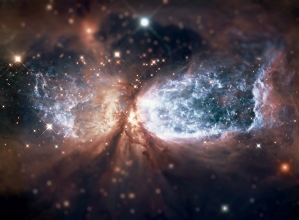Redshift, a definition:
the displacement of spectral lines toward longer wavelengths (the red end of the spectrum) in radiation from distant galaxies and celestial objects. This is interpreted as a Doppler shift that is proportional to the velocity of recession and thus to distance.
I wonder. When the universe expands, and our beloved objects appear to fly away from us, do we see red?
In a 1977 interview with The Paris Review, Stanley Kunitz said, regarding scientists:
The popular impression is that their metaphors are real and the poet’s metaphors are unreal. But both are trying to find metaphors for reality. It always haunts me that human beings were accumulating experience and knowledge in their bodies before they had a language. That’s where our oldest wisdom is. The language of the imagination is a body language. That’s why poetry is resistant to abstractions.
Below is one of Kunitz’s experiments in the use of metaphor, which makes reference to the concept of redshift he had heard astronomers speak of.
The Science of the Night
I touch you in the night, whose gift was you,
My careless sprawler,
And I touch you cold, unstirring, star-bemused,
That have become the land of your self-strangeness.
What long seduction of the bone has led you
Down the imploring roads I cannot take
Into the arms of ghosts I never knew,
Leaving my manhood on a rumpled field
To guard you where you lie so deep
In absent-mindedness,
Caught in the calcium snows of sleep?
And even should I track you to your birth
Through all the cities of your mortal trial,
As in my jealous thought I try to do,
You would escape me—from the brink of earth
Take off to where the lawless auroras run,
You with your wild and metaphysic heart.
My touch is on you, who are light-years gone.
We are not souls but systems, and we move
In clouds of our unknowing like great nebulae.
Our very motives swirl and have their start
With father lion and with mother crab.
Dreamer, my own lost rib,
Whose planetary dust is blowing
Past archipelagoes of myth and light
What far Magellans are you mistress of
To whom you speed the pleasure of your art?
As through a glass that magnifies my loss
I see the lines of your spectrum shifting red,
The universe expanding, thinning out,
Our worlds flying, oh flying, fast apart.
From hooded powers and from abstract flight
I summon you, your person and your pride.
Fall to me now from outer space,
Still fastened desperately to my side;
Through gulfs of streaming air
Bring me the mornings of the milky ways
Down to my threshold in your drowsy eyes;
And by the virtue of your honeyed word
Restore the liquid language of the moon,
That in gold mines of secrecy you delve.
Awake! My whirling hands stay at the noon,
Each cell within my body holds a heart
And all my hearts in unison strike twelve.
–Stanley Kunitz
During the past century or so, it has been an unusual event to discover a successful poem that contains both rhyme and meter. I realize that this one may not be to everyone’s taste. But I find a gentle and lyrical insistence in Kunitz’s desire to “Restore the liquid language of the moon.”
I read the poem several times, and seemed to hear it asking, directly and indirectly, the questions, “Who is the beloved?” and “Who am I?” Mysteriously, through some inner alchemy or space-time implosion, my brain arrived at this answer after re-reading: “all that is.”
Posted by Jillian Parker

This is simply an amazing post and poem. Thank you so much for posting. In the end, everything does come down to the body – Philsophy in the Flesh is a book I often recommend. This poem reminds me of wanting to study (no time to master) some scientific field, because some of the most amazing poetry seems to embed metaphors from science (and even math, to which science is reductible). Many think early humans “thought in math” way before language – in quantities, one might say, before descriptions. Something like that. I’m not certain I agree (except when I first heard it explained well). As for poetry’s being resistant to abstractions, I’d like to think on that, because as said, or to paraphrase, both science and art are grasping at metaphors, although many would say that that is untrue for science. But it has to be, because how are we to know reality – for real? Who are what, as confirmation?
LikeLiked by 2 people
Julie is so brilliant.
LikeLiked by 1 person
Julie, I’m so glad that you found this poem to your liking. It seems to grow on me. I’ve never read Philosophy in the Flesh, but if there is one axiom of “science” it is that we can never know all there is to know. In ancient times, art and the other sciences were closely entwined. Whatever mysterious force it is that keeps our hearts beating, perhaps it has a clue about reality.
LikeLiked by 2 people
Yes, the poem has generally an underground iambic pulse that kunitz occasionally phase shifts into trochaic for imperative emphasis…James Wright wrote in iambic meters early on…called the trochee, a “headless iamb.” I love meter and rhyme done subtly. Blank verse with end stops and end rhymes was mortally wounded by Whitman, although it took some years to die.
LikeLiked by 2 people
Imagination is a body-language. Great insight. And here to me is where it gets interesting – and where it becomes a battle of the “metaphors.” Kunitz said “poetry is resistant to abstractions.” But Kandinsky (and especially the abstract expressionists) say abstraction is “closer” to nature than anything – in fact as close as we can get. How does one express the imagination honestly (and “the body” for that matter) if not in forms that betray/transcend the figurative world? Is poetry really resistant to anything? Thank you for sharing this.
LikeLiked by 2 people
Reading Kandinsky can be misleading if you don’t realize that he had his beginnings in the very visual Russian tradition, where iconography was ever-present as symbolic metaphor, as windows to abstract concepts and inner worlds.
Here is the direction my thoughts lead me, after re-reading Kunitz’ poem several times: this is a love poem, written with reverence for the solitude of another’s soul, and I am growing fond of it. But why do I like it, when many love poems can be difficult to digest?
Let us remember that, while his contemporaries such as Charles Bukowski were living a the life of a “Bohemian” poet, and writing in broken phrases, Stanley Kunitz took a path less traveled. Kunitz settled down, married (several times, but long-term: his last marriage lasted over 40 years), gardened, assisted in the translation of poems, and wrote (sometimes) in metered verse. He lived in isolation; was not a popular writer, although he was named Poet Laureate; he had methodical routines. He would putter in the garden; have his daily cocktail; fix his wife dinner (he loved to cook); and would rise at midnight to write poems. Can you sense those daily rhythms and disciplines in his poem?
I’ll let Kunitz have the last word, again from the 1977 interview:
“A poem has secrets that the poet knows nothing of. It takes on a life and a will of its own. It might have proceeded differently—towards catastrophe, resignation, terror, despair—and I still would have to claim it. Valéry said that poetry is a language within a language. It is also a language beyond language, a meta-medium—that is, metabolic, metaphoric, metamorphic. A poet’s collected work is his book of changes. The great meditations on death have a curious exaltation. I suppose it comes from the realization, even on the threshold, that one isn’t done with one’s changes.”
LikeLiked by 1 person
Thank you, Jillian. I agree with the points made by the other commenters, so will not repeat.
LikeLiked by 1 person